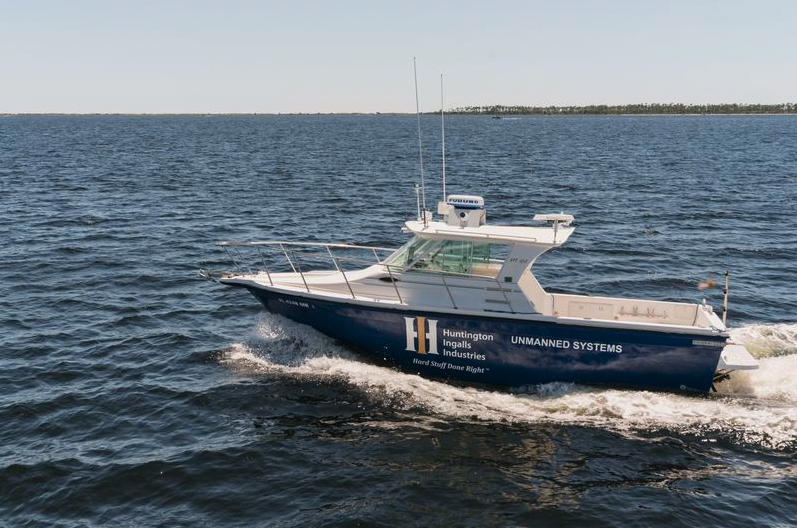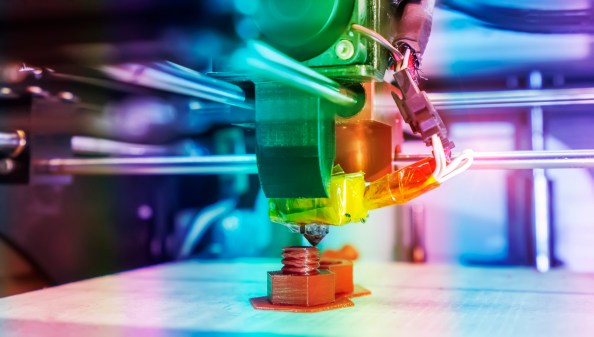How HII is posturing to be an ‘all-digital’ manufacturer

Unlike every former nuclear-powered carrier in the U.S. Navy that’s been produced at HII’s Newport News Shipbuilding dockyard, the future Ford-class carrier USS Enterprise (CVN-80) that’s now in the works there will be the first ever to be completely designed on computers and tablets, and physically built using digital manufacturing capabilities.
During separate briefings at HII’s new Arlington office on Jan. 8, two of its top executives spotlighted some of the company’s latest metrics and the milestones they’re eyeing in 2024.
In response to questions from DefenseScoop, they each discussed how the making of CVN-80 will set the tone for the company’s fully digital future — and their aims to build momentum around additive manufacturing in the near term.
“It’s a full slate for the year — it’s going to be very busy,” HII’s President and CEO Christopher Kastner said.
Historically, the company has been known as a top American submarine and shipbuilder. In a 2022 reshuffle to better spotlight its other major role as an all-domain defense solutions provider, HII renamed its Technical Solutions division to Mission Technologies. It was during that time that the company, formerly branded as Huntington Ingalls Industries, changed its name to HII.
That rebrand is about “keeping up with where the business is and with how the business is evolving,” Kastner told reporters, noting that the new iteration of the portfolio includes artificial intelligence and machine learning capabilities, unmanned and autonomous systems, software development, and more. “And we’ve had over $5 billion of awards in Mission Technologies [in 2023, through the third quarter],” he said.
In a technology-driven first for HII, the CVN-80 is the first carrier to be designed and produced digitally, using laptops, tablets and other “intelligent” tools.
“If you were to go and look at CVN-79, for mechanics in our footprint we’re using drawings. And many of you may know, but I’ll suggest it otherwise, drawings are inverted for the most part — so you imagine a mechanic looking up at a drawing because that’s how he has to look at it for how he’s working. So, when we talk about digital, we’re talking about not PDFs, we’re talking about interactive, and I’m using my fingers this way, because this is really what the mechanic can do to adapt [and] take the three-dimensional visual work and structure, they can move it around, they can go and remove parts and pieces,” an HII Newport News Shipbuilding executive told reporters on the condition of anonymity.
Relatedly, during a recent tour through HII’s manufacturing facility in Newport News, the company’s CEO Kastner walked up to an employee he passed for an unprompted engagement.
“This is a pretty experienced shipbuilder. I go, ‘Let me see what’s on your [tablet or pad], and how you are using that.’ And it was digital shipbuilding — it was digital work instructions. And I asked him, ‘How’s it going? How does that work for you?’ He goes, ‘It’s really intuitive. It’s simple to use. I don’t have to carry around a bunch of plans, and I don’t have to go back to the planning organization to understand all the different changes that went through engineering design,’” Kastner explained.
“So, digital shipbuilding and digital instructions work. We need to make sure that they’re employed beyond the aircraft carrier program, which they are being employed on the Columbia Class — but that’s just the tip of the iceberg,” he said.
A clean and strong data arsenal is also a key to the shipbuilder becoming a totally digital manufacturer.
Kastner told DefenseScoop during the briefing that HII is currently working in close partnership with Amazon Web Services to evaluate and learn how to best format and use all of its sprawling data.
Another unique technological feature of CVN-80 is that HII is making it with certain 3d-printed parts — or those created through advanced additive manufacturing processes.
“I’m proud to say that we have [additively manufactured] parts on CVN-80 right now,” the Newport News shipping executive said in their briefing.
But in order to build momentum around that progress, Naval Sea Systems Command (NAVSEA) technical authorities need to be met. For instance, the executive said HII has already printed JP-5 manifolds — parts that help move fuel.
“We’re in the process of getting that qualified through [NAVSEA]. That will be a great feat when that happens. So, it’s definitely an opportunity for us to increase momentum. CVN-81 would be the holding spot for the JP-5 manifolds when they become qualified,” the shipbuilding executive said.
The official told DefenseScoop that the main challenge in that approval process “has been the species of material to the specific part, and how we work through that collectively.”




